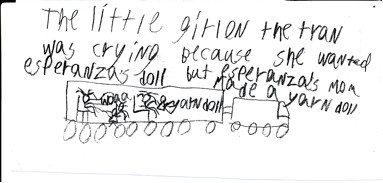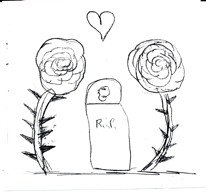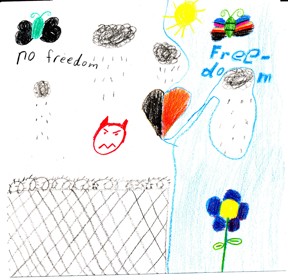Encouraging Symbolic Thinking through Literature
by Kathryn Bolasky, Third Grade Teacher, Van Horne Elementary School
Engaging my students in meaningful responses to literature was a tension for me throughout the school year. My students were proficient in making text-to-text, text-to-self, and text-to-world connections to literature, but I struggled with pushing them to dig more deeply into their interpretations. I wanted them to struggle with ideas and issues as they considered their understandings of literature, not just make a comment about a connection. Our teacher study group provided opportunities for me to explore new response strategies. Looking back over the year, I realize that one response strategy, Sketch to Stretch, became particularly significant. When I compared our initial sketches with ones completed during the last week of school, I was impressed and surprised by the change in the complexity of student thinking. By the end of the year, my students went from simply illustrating the events of a story to symbolically representing their understandings of literature through visual images.
Whitin (1994) defines Sketch to Stretch as “a visual representation of colors, lines, symbols, and shapes to convey one’s understanding of conflict, character, theme, or feelings” (p. 101). Readers do not illustrate the events of the story, but explore their meanings or connections to a story through visual images. Typically, we ask students to respond to literature through conversation or a writing. Short, Harste, and Burke (1996) argue that language is not the only way to create meaning and that there are many sign systems that we use as human beings to “share and make meaning,” including music, art, mathematics, drama, and language. Sketch to Stretch involves moving from the sign system of language to the sign system of art, a process called transmediation. Short, Harste, and Burke point out that transmediation is not just a translation or transfer of meaning from one system to another. Each sign system has a different meaning potential and so readers have to transform the meaning they have created in language as they move into art. This transformation encourages readers to go beyond a literal understanding of their reading and supports complexity in student thinking as well as the ability to think symbolically about significant concepts within the book.
I was introduced to Sketch to Stretch as a response strategy in study group and was anxious to try it out with my class. I was reading aloud Esperanza Rising (Ryan, 2000) and decided to have students respond in literature logs. I had been struggling to engage students in meaningful discussions with each other and hoped that responding in lit logs and using Sketch to Stretch would provide them with ideas to talk about in the discussion. This novel captures the compelling story of a young Mexican girl who immigrates to a new country and into a different social class. The death of her wealthy, loving father results in her uncle’s pressuring her mother to remarry one of them, and so Esperanza and her mother are forced to leave their ranch and belongings behind and flee to a new life as migrant workers in California.
I explained that I wanted students to explore the big ideas of the chapter using pictures or words. My past experience as a primary teacher led me to believe that using pictures as a response would ease their anxiety about putting their thoughts into writing. Their responses incorporated both writing and pictures, but only showed basic comprehension of the events in the story. Even though their responses were retellings, not sketches of meanings, the sketches were a significant step in developing their thinking about literature because they were using more than one sign system to visually represent events from the story.
Their sketches indicated that students were able to identify the important events in each chapter, but they could not explain why those events were important. Mason’s response depicts a pivotal scene from the Chapter 7 where Esperanza and her mother are on the train and a young passenger wants to play with Esperanza’s treasured doll. This part of the story is a turning point for Esperanza and her mother, because Esperanza interacts with someone who is poor for the first time. She has grown up in Mexico with wealth and privilege and her mother explains that they are now also struggling with poverty. Choosing to respond to this part of the chapter indicated that Mason understood the importance of the event, but he could not explain why this event is significant to the story.
Even though a majority of the responses were retellings of events, a few students did use visual symbols related to the events. Dan drew a wedding ring and a wedding band, with the caption “ring- will you marry me,” to show that Esperanza’s uncle wanted to marry her mother. During the discussion of this chapter, Dan indicated that he saw this as an important event, but he could not explain why. Elana used facial expressions to represent the change in Esperanza’s uncle’s personality. Esperanza’s perceptions of her uncle change in the story and Elana noted the shift, but was not able to verbally explain how that affected the story.
Bailey’s response gave me hope about using Sketch to Stretch to push student thinking. Bailey was able to effectively use symbols to signify Esperanza’s father’s death. She drew a grave marker that was framed by two roses and she explained that the roses symbolized Esperanza and her mother. On each stem there were large thorns. She drew a heart above the gravestone and the two roses to show the love they had for each other. Bailey’s response showed me that my students could move past retellings into deeper understandings of a text.
I decided to use the conceptual frame we were focusing on in Learning Lab to guide and push our thinking. Our teacher study group had decided to look at human rights and the power of choice. With the help of Lisa Thomas, I selected a few picture books from a text set on our central theme and read aloud When I Grow Up I Will Win the Nobel Prize (Pin, 2006), First Day in Grapes (Perez, 2002), and The Big Box (Morrison, 2002). I started our discussions by asking, “Who had the power to make choices for a better world?” This question provided a starting point for student responses and jump started many discussions. I also made an effort to demonstrate my thinking about the important decisions that were occurring within each story. The students were able to look deeper into the stories that we read. They talked about decisions that characters were making and explored why these choices were significant in that character’s life and world. As our discussions developed, I noticed that the students were creating more detailed sketches as well because of the support of this talk in exploring and developing their thinking about different interpretations for a book.
These experiences demonstrated that students needed to explore their initial interpretations of literature before moving into the sketching. I originally thought that Sketch to Stretch responses would develop student discussions, but I came to understand that students needed to engage in exploratory talk about a book before moving to symbolic thinking. Symbolic thinking was new to them and they needed the initial sharing to help them consider possible issues and interpretations to explore symbolically through visual images and then could move back into more in-depth dialogue about the book. Freedom Summer (Wiles, 2001) was a key picture book that helped shift our thinking from using art to summarize a plot to using art to symbolically represent the deeper meanings of the story. Set in Mississippi in the summer of 1964, the book portrays the close friendship of two boys, one black and the other white, who celebrate the passage of the Civil Rights Act by going to the town pool, expecting to be able to swim together for the first time. Instead, they find a work crew filling the pool with asphalt, a reflection of the town’s resistance to desegregation.
Lisa read aloud the book and gave students time to talk about their questions before asking them to sketch. By discussing first, the students talked through their confusions and helped each other go beyond recounting the plot into interpretations. Through the discussions students learned to think interpretively and this supported them in moving into symbolic thinking. The students could take their new understandings and create sketches of the concepts and ideas that they each wanted to think more about.
Elena took ideas from the story that were discussed and effectively used visual images to explain her understanding. She used symbols to show the many tensions in the story. Her sketch is divided into two parts to represent the perspectives of the two boys. On the left side of the paper she has a chain link fence with barbed-wire across the top, storm clouds that are raining, and a butterfly with black wings. These images are juxtaposed against the visual images on the right side of the sketch which depict a blue sky, sun, brightly colored butterfly, and flower. Most of Elana’s understandings of the tensions in the story are illustrated in the middle of the sketch. She drew a blue line to clearly delineate the two sides, but it was not a straight line. Instead she drew a curvy line with a heart and an area that bulges into the blue sky of the right side.
When I interviewed Elana about her sketch she was very confident as she explained each aspect. She said that the left side is supposed to be dark and sad because that is how John Henry felt about not being able to do things that Joe could do. She created the right side to represent Joe’s feelings about being happy, except when John Henry was discriminated against because of the color of his skin. She explained that she showed Joe’s frustration with the inequality by putting a dark cloud and rain in the middle of his blue sky to indicate that not all of him is happy. This piece of cloudy, rainy sky is like the piece of Joe’s heart that is sad and frustrated. I was impressed with Elana’s ability to clearly capture the main character’s frustrations in her sketch. Her sketch was more than an illustration of an event from the story–it was a look into her thinking about the text. When I saw all of the students’ sketches displayed on a bulletin board in the Learning Lab, I realized that my class was able to use visual images as symbols to express and deepen their thinking.
After our success with Freedom Summer, I wanted to continue to use Sketch to Stretch as a response to our next read aloud. Due to our focus on human rights and the power to make decisions for a better world, I was reading aloud Iqbal (D’Adamo, 2001) to my class. Iqbal is a fictional story based on the life of a young boy who led an influential movement to protest child labor in Pakistani carpet factories. I knew that I would have to create an atmosphere where students could ask questions and thoughtfully discuss the tough issues in the book. I gave out literature logs and encouraged children to respond in any way they felt made sense. I set aside the last thirty minutes of each day to read a chapter from the book. After finishing a chapter, students responded in their literature logs and then we had a discussion. The students were involved in the story and always looked forward to the last half an hour of the day. I was surprised by the deeper understandings of the concepts, ideas and issues that students brought up during discussion, such as illiteracy, poverty, and justice. Based on their conversations and emotional connections to the story, I realized that the students were engaging with this story in ways I had never seen before. When we finished the book I explained to the class that they were going to do a Sketch to Stretch about the overall meaning of the book for each of them. The students immediately read through their literature logs and got to work on their sketches.
As students shared their sketches with each other, I was astounded at their ability to use visual images as symbols to represent their understandings. Many of the students used symbols that we had talked about in our discussions like birds symbolizing freedom and rainbows symbolizing hope. When Dan shared his sketch, he explained that he drew the chain that was used to imprison Iqbal to his loom and it was “empty” showing that Iqbal was free. He said that he drew the top part of his sketch as dark and red because Iqbal was angry because he knew it was wrong to be chained to the loom and forced to make carpets. He shared that he left the image white behind the loom because Iqbal knew he could be free and that he was going to make it happen. Dan recognized that Iqbal was intelligent and knew child labor was wrong and was brave enough to stand up for himself and other children. Dan used the chain as a symbol of strength not despair.
Gaby shared that she drew a kite to show freedom because Iqbal and Fatima dreamed of the day that they could fly a kite and were free from the looms and their master. She also explained that she drew the kite “breaking through a fence” that held in the kids. The clouds in the sky were another symbol of freedom because the kids could not see the sky when they were working in the shop. The small details in their drawings indicate that students had listened carefully to this intense story, made their own meanings, and created visual images to show their new understandings.
Sketch to Stretch was more than just a response strategy to literature in my classroom. These sketches are an illustrated record of our learning. Through examining how the students’ sketches unfolded over time, I was able to see the ways in which my students developed more symbolic and conceptual thinking, as well as how my own learning as a teacher developed. I originally planned to use Sketch to Stretch as a way to encourage thoughtful talk about literature, but quickly learned that we needed to first engage in exploratory talk to share our initial responses. This exploratory talk provided students with the support they needed to consider their own interpretations and engage in transmediation to move their talk into symbolic representations of our thinking. We needed to think together and I needed to demonstrate and encourage symbolic thinking to support them in creating a sketch.
As an educator it is sometimes hard to abandon carefully developed lesson plans, but in this case it was essential to do so to support my students as critical thinkers. I could have easily judged their first attempts at sketching as an indication that third graders could only illustrate events from a text. Through taking a closer look at their sketches, I saw glimpses of symbolic thinking starting to emerge. By taking instructional time to build strategies and ways of thinking about books, my students moved past their surface understandings of a text. Sketch to Stretch gave students a way to create visual images of their thinking and this move from language to visual thinking transformed their understandings and, in turn, led to richer dialogue. Action research provided a way for me to examine these small shifts in student thinking over time and, in turn, transformed my understandings about children’s potential to engage in symbolic thinking.
References
WOW Stories, Volume I, Issue 2 by Worlds of Words is licensed under a Creative Commons Attribution-NonCommercial-ShareAlike 4.0 International License.
Based on a work at https://wowlit.org/on-line-publications/stories/storiesi2/.








One thought on “WOW Stories: Connections from the Classroom”